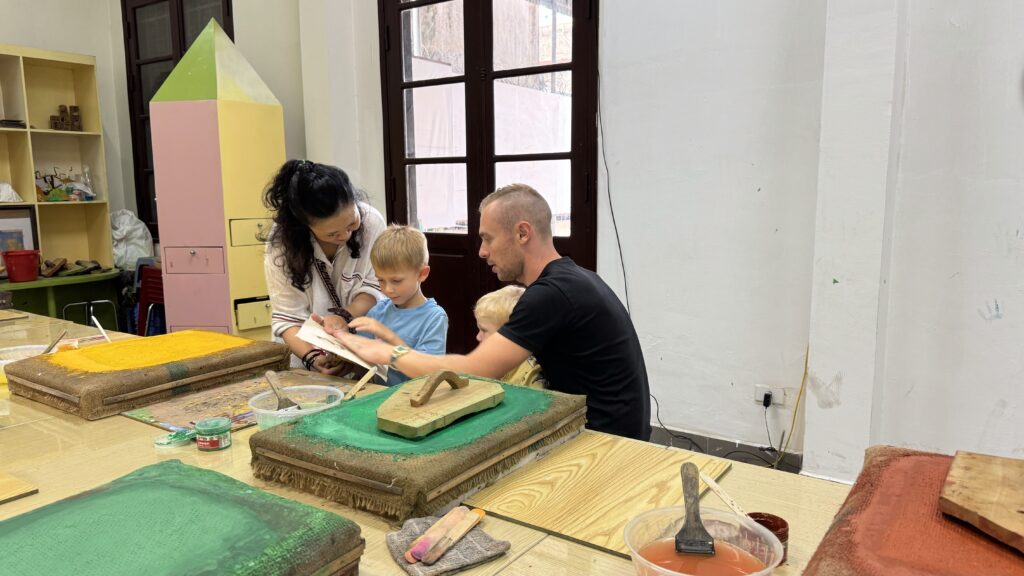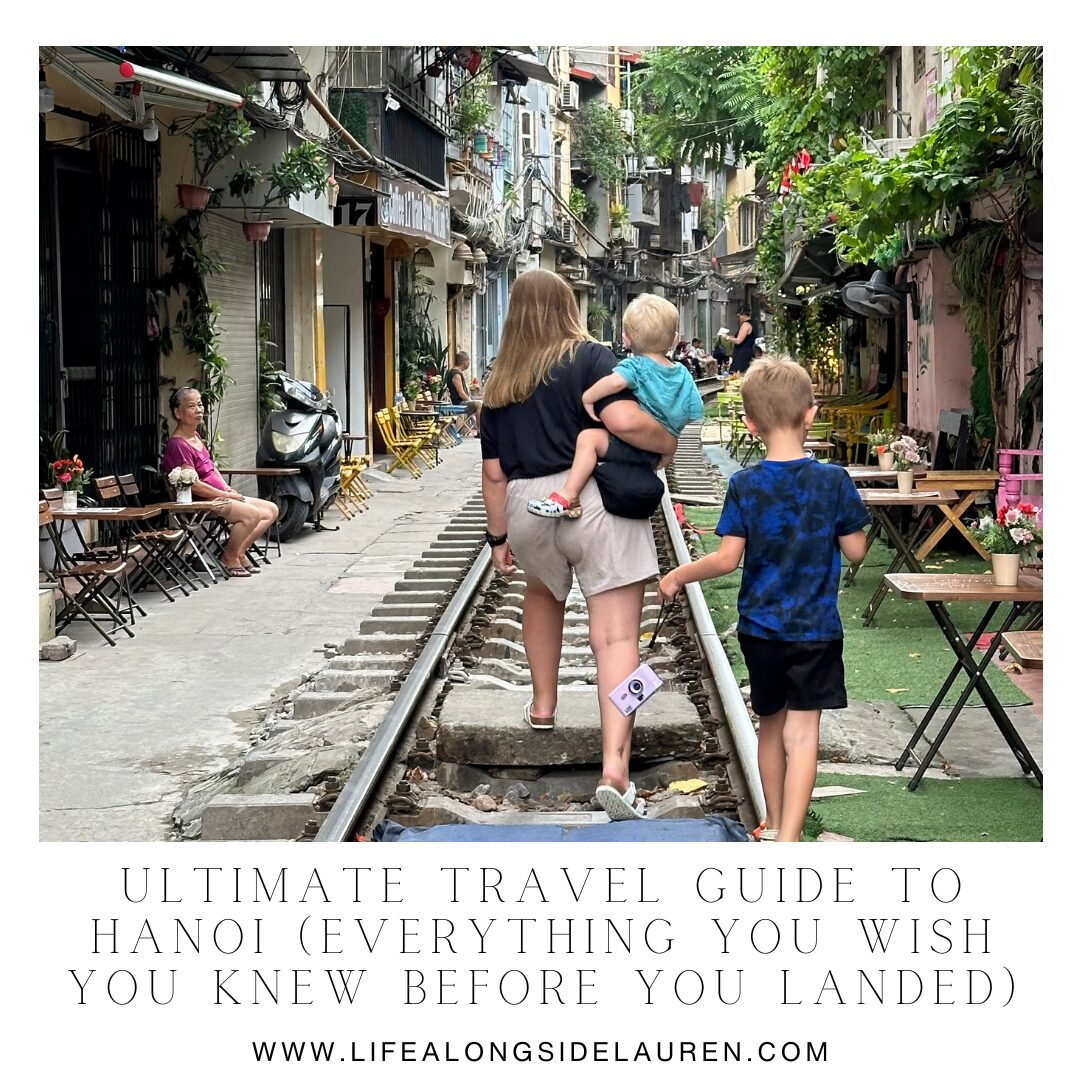Ultimate Travel Guide to Hanoi (Everything You Wish You Knew Before You Landed)
Planning a trip to Hanoi? Buckle up, buttercup, because this city is a whirlwind of scooters, sizzling street food, and surprises at every turn. Think sensory overload in the best possible way. One minute you’re sipping egg coffee in a cosy café, the next you’re dodging motorbikes like you’re starring in your own real-life action movie. Hanoi doesn’t politely invite you in; it grabs you by the hand (and the stomach) and sweeps you along for the ride, so here’s your ultimate Travel Guide to Hanoi.
Whether you’re a first-timer wondering if you’ll survive crossing the street (spoiler: you will, and you’ll feel like a superhero afterward) or a seasoned traveller ready to dig into every bowl of pho in sight, this sassy yet practical Travel Guide to Hanoi is here to give you everything you wish someone had screamed at you before you touched down. The good, the chaotic, and the downright delicious.
Ready? Let’s dive right in scooters, snacks, scams, and all.
Best Time to Visit Hanoi; When to Book Your Trip
If you’re wondering when is the best time to visit Hanoi, the short answer is: avoid peak monsoon season unless you’re a fan of soggy shoes. The sweet spots are from October to April, where you’ll find cooler, drier weather perfect for sightseeing. In this Travel Guide to Hanoi, we recommend Spring (March to April) as particularly lovely, with warm days and blooming flowers. Autumn (October to November) gives you crisp air and blue skies that will make your Instagram photos pop. Summer (May to September) is hot, humid, and rainy – basically, it feels like walking around inside a giant rice cooker.
How to Get to Hanoi; Flights, Trains, and Buses
Alright, so you’ve survived the flight, the immigration line, and possibly a teeny existential crisis at baggage claim. Now what? Time to actually get into Hanoi — and you’ve got options, my friend! In this Travel Guide to Hanoi, we’ll break down the best ways to get from the airport to the hustle and bustle of the city centre without losing your mind (or your wallet). Whether you’re a first-timer or a seasoned traveller, here’s everything you need to know to start your Hanoi adventure on the right foot.
Option 1: Taxi
If you just want to get there now without thinking too hard (no shame, jet lag is brutal), grab a taxi.
Tips:
- Use an official airport taxi like Mai Linh (green cars) or Vinasun (white cars).
- Make sure the driver turns on the meter — or agree on a price first.
- Expect to pay around 350,000 to 450,000 VND (£11–£14).
- Journey time is around 40–60 minutes depending on how spicy the traffic is feeling that day.
If some random guy grabs your bag and hustles you to a random car, abort mission. Stick to the official taxi desks inside the terminal or order one through Grab (Vietnam’s answer to Uber).
Option 2: Grab
Download the Grab app before you land (trust me, airport Wi-Fi is hit or miss).
- Book a GrabCar straight from the app.
- Prices are usually 250,000–350,000 VND (£8–£11).
- You can pay by cash or card (depending on your setup).
If you really want to flex your savvy traveller status, head up to the Departures level (2nd floor) and order your Grab from there. It’s way less chaotic than Arrivals.
Option 3: Airport Bus
Feeling adventurous and frugal? The public airport buses are ridiculously cheap and honestly not that bad.
- Bus #86 is your best bet — it’s the “Tourist Bus” and super easy to spot (bright orange).
- It runs from the airport straight to major stops in the Old Quarter.
- It costs around 45,000 VND (£1.40) — an absolute bargain.
- Runs roughly every 20 minutes from 5:30am to 10:30pm.
Keep small bills handy and don’t expect luxury — it’s basic but it gets the job done.
Option 4: Private Transfer
If you’re arriving late at night, have heaps of luggage, or just want someone standing there holding your name like you’re Beyoncé, book a private transfer.
- Pre-book online through sites like Klook or 12Go Asia.
- Costs around 350,000–600,000 VND (£11–£19) depending on the service level.
- They’ll meet you right at Arrivals with a sign, no stress, no mess.
Double-check your hotel — lots of places in Hanoi offer airport pickups for a very reasonable price if you book ahead.

What Areas to Stay in Hanoi
Hanoi is a city of contrasts, so where you stay can really set the tone for your trip. Whether you’re looking to be right in the action or prefer a quieter retreat, there’s a perfect spot for everyone. In this Travel Guide to Hanoi, we’re breaking down the best areas to base yourself during your Hanoi adventure from buzzing streets to peaceful corners where you can unwind after a busy day of exploration. Let’s dive in!
Old Quarter: The Heart of Hanoi
If you want to be in the thick of things, the Old Quarter is your best bet. It’s vibrant, chaotic, and bursting with energy. Think narrow streets lined with street food stalls, local shops, and centuries-old architecture. You’ll be close to iconic landmarks like Hoan Kiem Lake, the Water Puppet Theatre, and a whole lot of Vietnamese history.
- Vibe: Bustling, lively, and full of character.
- Best for: First-time visitors, foodies, and those who want to be in the center of the action.
- Pros: Close to major attractions, great for street food and shopping, and a central location.
- Cons: Busy and noisy — not ideal for those seeking peace and quiet.
Hoan Kiem Lake: Central and Scenic
Hoan Kiem Lake is often considered the beating heart of Hanoi. Staying here puts you in close proximity to the Old Quarter but in a slightly quieter, more scenic setting. The area around the lake has a mix of luxury hotels, charming cafes, and pedestrian-friendly spaces. It’s perfect if you want a balance between convenience and a more relaxed atmosphere.
- Vibe: Peaceful, scenic, and charming.
- Best for: Those who want a central location with a touch of tranquility.
- Pros: Beautiful lake views, close to the Old Quarter, and plenty of things to see and do.
- Cons: Hotels can be a bit pricier compared to the Old Quarter.
French Quarter: Elegant and Refined
The French Quarter is perfect for those who appreciate a bit of colonial charm. Think wide boulevards, colonial-era architecture, and quieter streets compared to the Old Quarter. Here, you’ll find some of Hanoi’s most luxurious hotels, upscale restaurants, and embassies. It’s also home to some fascinating attractions like the Hanoi Opera House.
- Vibe: Elegant, sophisticated, and relaxed.
- Best for: Couples, luxury travelers, or anyone looking for a more refined stay.
- Pros: Less crowded, scenic, and more upscale with a European feel.
- Cons: More expensive and a little farther from the hustle of the Old Quarter.
West Lake: Peaceful and Picturesque
If you’re looking for a quieter, more laid-back vibe, West Lake (Tay Ho) is where you’ll want to be. This residential area is known for its leafy streets, scenic views, and slower pace. It’s a bit removed from the tourist frenzy but still has plenty to offer in terms of restaurants, cafes, and boutique shops. It’s ideal for families or those who want a more local, peaceful experience while still being close to the action.
- Vibe: Relaxed, peaceful, and residential.
- Best for: Families, long-term travelers, or those who want a break from the hustle.
- Pros: Scenic views, peaceful, and less touristy.
- Cons: A bit farther from major attractions, though public transport can get you there easily.
Ba Dinh: For History Buffs and Locals
Ba Dinh is where you’ll find some of Hanoi’s most important historical landmarks, like the Ho Chi Minh Mausoleum and the One Pillar Pagoda. It’s a quieter, more local area with a mix of government buildings, parks, and residential spots. While it’s not as bustling as the Old Quarter, it’s still close to key sights and offers a more authentic Hanoi experience.
- Vibe: Historical, quiet, and local.
- Best for: History lovers, those looking for a quieter, more cultural experience.
- Pros: Close to major historical sites, more local vibe, less crowded.
- Cons: Farther from the main tourist action, so less lively.
Dong Da: Off the Beaten Path
If you’re looking to experience Hanoi from a more local perspective, Dong Da offers an authentic experience without the tourist crowds. This area is home to markets, local food stalls, and a more everyday vibe. It’s ideal for budget travelers or those who want to explore beyond the usual tourist spots. It’s also well connected to public transportation, so you can easily explore the rest of the city.
- Vibe: Authentic, local, and off-the-beaten-path.
- Best for: Budget travelers or anyone wanting to experience a more local, everyday Hanoi.
- Pros: Cheaper accommodations, more authentic vibe.
- Cons: Far from most tourist attractions, a bit more difficult for first-timers to navigate.
Which Area Should You Choose?
- First-time visitors? Stick to the Old Quarter or Hoan Kiem Lake for easy access to all the main attractions.
- Luxury travelers? The French Quarter or Hoan Kiem Lake will give you elegance and convenience.
- Families or those seeking peace? Opt for West Lake for a slower pace and spacious accommodations.
- History buffs? Ba Dinh offers plenty of historical significance.
- On a budget? Go for Dong Da to experience Hanoi like a local without the price tag.
Wherever you choose to stay, Hanoi’s neighborhoods each offer a unique flavor of the city. So, pick your vibe and get ready to explore this buzzing metropolis!

Things to Do in Hanoi with Kids
Explore the Old Quarter
Wander through the Old Quarter’s 36 buzzing streets, each originally dedicated to different trades. Get lost (you will, it’s fine) and soak up the chaos, charm, and epic street food.
Visit Hoan Kiem Lake
Chill out around Hoan Kiem Lake and watch locals practice tai chi at dawn. Snap a pic of the Turtle Tower and stroll across the iconic red Huc Bridge to Ngoc Son Temple.
Check Out the Temple of Literature
History nerds (and architecture lovers) will adore this 11th-century university dedicated to Confucius. It’s one of Hanoi’s prettiest and most peaceful spots.
Ho Chi Minh Mausoleum
Yes, Uncle Ho is actually preserved here. Dress modestly, be respectful, and maybe don’t think too hard about the science involved.
Water Puppet Theatre
It sounds bizarre, but trust us, the Thang Long Water Puppet Theatre is iconic. It’s a cultural must-do that kids (and secretly adults) will love.
Hidden Gems in Hanoi That Locals Love
Long Bien Bridge
Designed by Gustave Eiffel himself, this historic bridge is best explored at sunrise when the city is just waking up. It’s a slice of real Hanoi life.
Train Street
Yes, it’s a street with a literal train running through it. While some parts are closed to tourists, nearby cafes still offer a thrilling (and slightly terrifying) view.
Phung Hung Mural Street
An underrated gem where the old walls have been transformed into stunning murals showcasing Hanoi’s culture and history.
Kid-Friendly Travel Tips for Hanoi
Travelling to Hanoi with kids? You’re a legend. The chaos can be thrilling or overwhelming, depending on nap schedules.
- Stick close to Hoan Kiem Lake for wide open spaces to run around.
- Water puppet shows are a hit for little ones.
- Avoid rush hour traffic walks (unless you enjoy mild panic).
- Many cafes have play areas – seek them out for a breather.
What Food to Try in Hanoi (And What to Avoid)
Must-Try Dishes
- Pho: Breakfast, lunch, dinner – there’s no bad time for a steamy bowl.
- Bun Cha: Grilled pork and noodles so good it made Obama and Anthony Bourdain share a meal.
- Egg Coffee (Ca Phe Trung): Sounds weird, tastes like a caffeinated dessert.
- Banh Mi: French-inspired Vietnamese sandwiches that will ruin you for Subway forever.
Foods to Be Cautious About
If you want to avoid spending your precious holiday hours within sprinting distance of a bathroom, tread carefully with:
- Street snails: Adventurous, but not always fresh.
- Unpeeled fruits: Wash ’em or peel ’em yourself.
- Ice in random places: Stick to restaurants or cafes with good reviews for your iced drinks.

Transport Tips and Hacks for Getting Around Hanoi
- Grab App: Cheap, reliable, and spares you from haggling.
- Walking: Yes, you can walk a lot of Hanoi, but watch out for sudden scooters on sidewalks.
- Cyclo Tours: Fun for a quick spin through Old Quarter, but bargain hard before you hop in.
- Buses: Dirt cheap but confusing – only for the adventurous (or extremely broke).
Local Etiquette and Common Scams in Hanoi
Etiquette Tips
- Smile a lot.
- Dress modestly when visiting temples.
- Always remove your shoes before entering someone’s home.
- Avoid pointing your feet at people or religious items (super rude).
Scams to Watch Out For
- Overcharging taxis: Use Grab.
- Friendly shoeshiners: They “fix” your shoes for a hefty surprise fee.
- Street vendors thrusting items into your hand: If you touch it, they expect you to buy it.
What to Pack for Hanoi: Essentials You’ll Thank Yourself For
- Light layers: Weather swings are real.
- Good walking shoes: Uneven sidewalks are everywhere.
- Power adapter: Vietnam uses types A, C, and D plugs.
- Travel umbrella: Instant monsoon coverage.
- Charcoal tablets or Imodium: You know why.
- Cheeky extras: A silk scarf (bought there, obviously), portable fan, and an emergency stash of tissues (public bathrooms are BYOTP: bring your own toilet paper).
Things I Wish Someone Had Screamed in My Face Before Going to Hanoi
When I landed in Hanoi, bright-eyed and buzzing from too much airplane coffee, here’s what no one warned me about but absolutely should have:
First of all, traffic has no rules. Crossing the street feels like a real-life game of Crossy-road. The secret? Walk slowly, confidently, and never backtrack. The scooters will flow around you like you’re Moses parting the Red Sea.
Cash is king, but small denominations are your real superpower. Nothing makes a vendor grumpier than having to break a huge bill for a 10,000 VND bottle of water.
Hanoi’s air quality can slap you in the face, especially in winter. If you’re sensitive, bring a good face mask. Or just accept that you’re inhaling a year’s worth of motorbike fumes for the full authentic experience.
Tipping isn’t expected but giving a little extra for great service will make you a hero in the eyes of your pho vendor.
Haggling isn’t rude. Vendors expect you to negotiate, so channel your inner drama queen and have a little fun with it.
Finally, embrace the chaos. Hanoi isn’t tidy, quiet, or always logical but that’s exactly why you’ll fall madly in love with it.

Frequently Asked Questions (FAQ) Travel Guide to Hanoi
1. Is Hanoi safe for tourists?
Yes, Hanoi is generally considered safe for tourists. Like any major city, it’s important to be aware of your surroundings, especially in crowded areas like the Old Quarter. Petty theft, such as pickpocketing, can happen, so always keep an eye on your belongings. Also, be cautious when crossing the street—traffic can be chaotic, but as long as you walk steadily, the scooters will usually avoid you!
2. What’s the best time to visit Hanoi?
The best time to visit Hanoi is during the spring (March to April) or autumn (September to November). During these months, the weather is mild, with cooler temperatures and less rain. Summer (June to August) can be hot and humid, while winter (December to February) can get quite chilly, especially in the evenings.
3. How do I get from Noi Bai Airport to the city center?
There are several options to get from Noi Bai International Airport (HAN) to the city center:
- Taxi: A taxi ride will cost around VND 350,000 to 400,000 and take about 30-45 minutes, depending on traffic.
- Airport Shuttle: Many hotels offer shuttle services, so check with your accommodation beforehand.
- Public Bus: The bus is the most affordable option, with tickets costing around VND 9,000, but it takes longer (up to 60 minutes).
- Ride-hailing apps (Grab): Grab offers a more affordable and convenient option compared to taxis, with prices typically between VND 200,000 – 250,000.
4. What’s the best way to get around Hanoi?
Hanoi has several transportation options:
- Walking: The Old Quarter is very pedestrian-friendly and the best way to explore the city’s narrow streets.
- Cyclo (rickshaw): A fun and traditional way to see the Old Quarter, though make sure to agree on a price before you hop in.
- Motorbike taxis (Xe Om): Great for short trips around the city, but make sure to negotiate the fare upfront.
- Grab (Ride-hailing app): A convenient way to get around, especially if you’re unfamiliar with the city.
- Public Buses: A very affordable option, though it can be crowded and less convenient for tourists.
5. Do I need a visa to visit Hanoi?
Visa requirements depend on your nationality. Many countries require a visa to enter Vietnam, but citizens of certain countries can enter visa-free for short stays (usually 15 days). You can apply for a visa on arrival or an e-visa online for stays of up to 30 days. Always check the latest visa regulations before you travel.
6. What’s the local currency in Hanoi?
The local currency is the Vietnamese Dong (VND). It’s best to carry cash, as many smaller shops and street vendors don’t accept cards. ATMs are widely available throughout the city, but make sure to inform your bank of your travel plans to avoid any issues with your cards.
7. How can I avoid traffic in Hanoi?
Hanoi’s traffic is infamous for being chaotic. To avoid the worst of it:
- Avoid peak hours (8:00 – 9:30 AM and 5:00 – 7:00 PM) when the traffic is at its heaviest.
- Use Grab or taxis to navigate during rush hours as they can often bypass traffic jams using side streets.
- Walk around the Old Quarter — it’s more pedestrian-friendly and avoids the traffic mayhem.
8. Is Hanoi a family-friendly destination?
Absolutely! Hanoi offers a range of family-friendly attractions, from the water puppet shows and parks to museums and lakes. The city’s streets can be busy, but most areas, like Hoan Kiem Lake, are ideal for little ones to explore. Plus, Vietnamese food is diverse and offers something for even picky eaters.
9. What’s the food like in Hanoi?
Hanoi is a food lover’s paradise! Known for its street food, you’ll find everything from Pho (noodle soup) and Bánh Mì (sandwiches) to Bún Chả (grilled pork and noodles). Street food stalls are everywhere, and the dishes are typically fresh, flavorful, and inexpensive. Don’t be afraid to try something new — it’s all part of the Hanoi experience!
10. Can I drink tap water in Hanoi?
It’s advisable to avoid drinking tap water in Hanoi. Stick to bottled water, which is widely available throughout the city. If you’re staying in high-end hotels, they may provide filtered water, but always double-check.
11. How long should I stay in Hanoi?
A typical stay in Hanoi is 3 to 4 days, which gives you enough time to explore the city’s top attractions, sample the local cuisine, and take in the unique atmosphere. If you want to take day trips to places like Halong Bay or Ninh Binh, consider extending your stay to 5 or 6 days.
12. Are there day trips from Hanoi?
Yes! Hanoi is an excellent base for day trips to nearby destinations:
- Halong Bay (4 hours away) – Famous for its stunning limestone karsts and emerald waters.
- Ninh Binh (2 hours away) – Known as “Halong Bay on land,” with scenic landscapes, caves, and temples.
- Sapa (8 hours away) – A bit farther, but great for trekking and experiencing the culture of the hill tribes.
Got more questions? Drop them in the comments or reach out directly! Hanoi is waiting, and trust me, it’s an adventure you won’t forget!
Is Hanoi Worth Visiting?
Short answer? Absolutely, outrageously, YES. If you’re still wondering whether to make the trip, then this Travel Guide to Hanoi is about to convince you. Hanoi will dazzle you, confuse you, exhaust you, and somehow leave you wanting more.
It’s a place where old-world charm meets the buzz of modern life, where every corner hides a delicious snack, and where the best stories are found by simply wandering without a plan. A well-crafted Travel Guide to Hanoi will show you the many layers this city has to offer.
So pack your bags, your sassiest attitude, and your biggest appetite. Hanoi is waiting for you – scooters, street food, and all. Trust this Travel Guide to Hanoi to ensure you don’t miss a beat while you experience it all.
Stay Connected for More Family Adventures!
Follow me on social media for more family-friendly travel tips, hidden gems, and staycation ideas across the UK and beyond.
🎥 TikTok – behind the scenes of our full time travel
📸 Instagram – for real-time travel inspo
📌 Pinterest – pin your next family adventure
👍 Facebook – join our community of travel-loving families







This is one of the most detailed travel guides about Hanoi I’ve ever read. It’s really something every traveler should read before visiting the city. Thank you for your post!